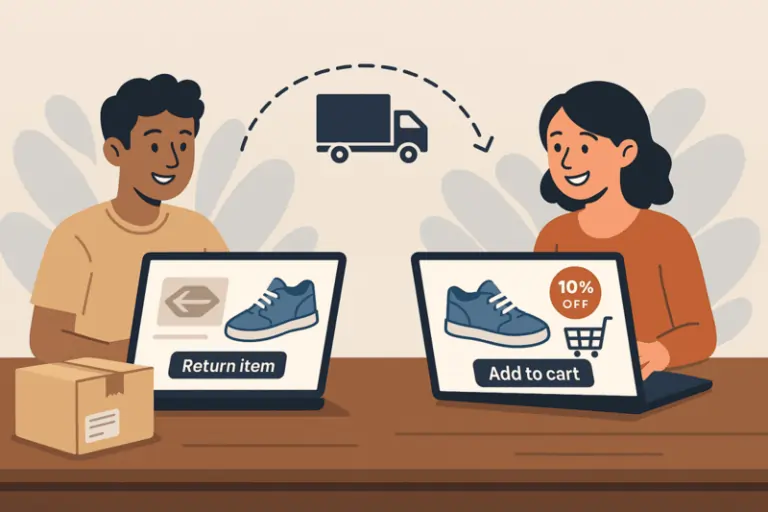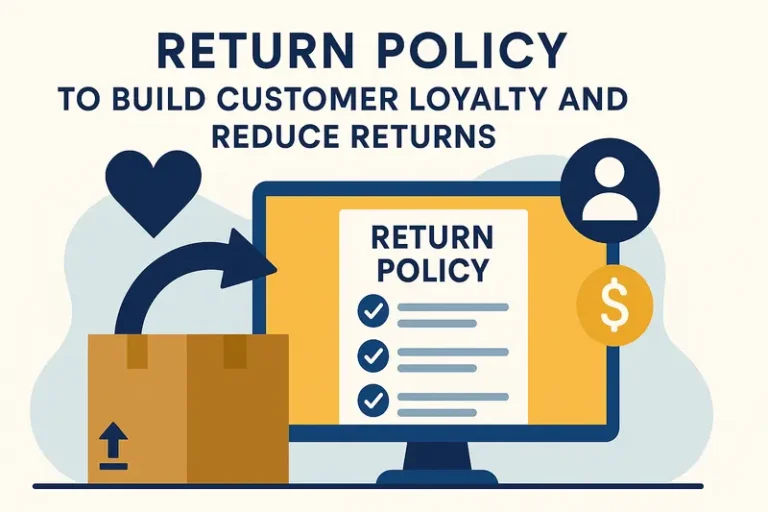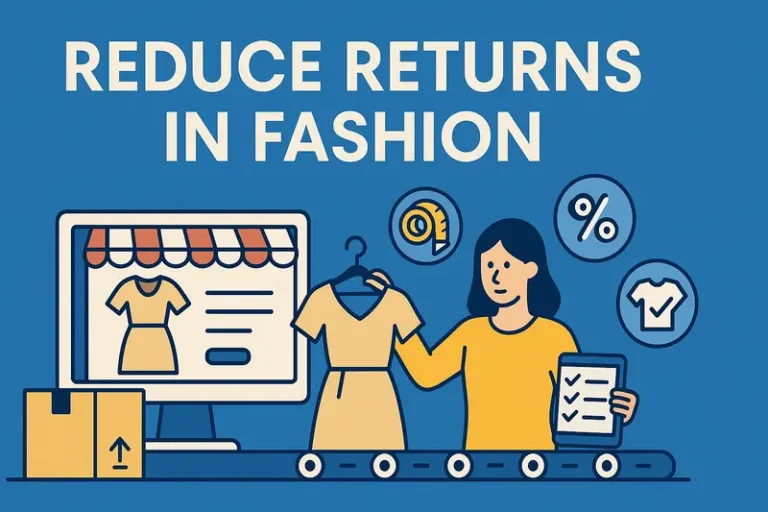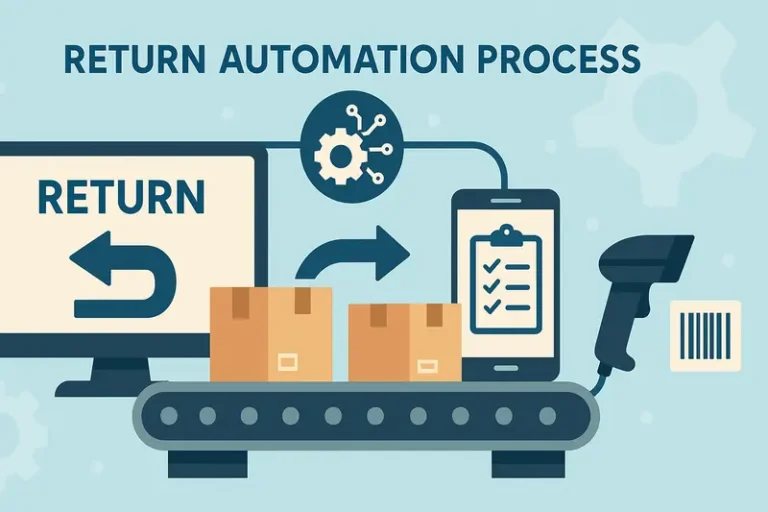Why Choose a Peer-to-Peer Returns Management Model over Traditional Methods?

Last updated on May 1, 2025

In this article
 13 minutes
13 minutes
- Key Takeaways
- Understanding the Importance of Returns Management in Ecommerce
- Key Components of an Effective Returns Management Process
- Leveraging Technology for Returns Management
- Best Practices for Reducing Return Rates
- Handling Returns to Boost Customer Loyalty
- The Role of Reverse Logistics in Returns Management
- Implementing Sustainable Returns Practices
- Peer-to-Peer Returns: The Future of Reverse Logistics
- Future Trends in Returns Management
- Summary
- Frequently Asked Questions
Managing returns in ecommerce is key to reducing costs and improving customer loyalty. With return rates exceeding 20%, effective returns management in ecommerce impacts profitability and operational efficiency. This article covers critical strategies and tools to optimize your returns process, from authorization and return transportation to using technology effectively.
Key Takeaways
- Peer-to-peer returns management enhances customer experience by reducing shipping delays and operational costs compared to traditional methods.
- An effective returns management process includes key components such as authorization and validation, efficient return transportation, and thorough inspection and grading of products.
- Implementing technology, including returns management software and data analytics, streamlines the returns process and boosts operational efficiency.
Understanding the Importance of Returns Management in Ecommerce

Returns management is the backbone of a healthy supply chain and a cornerstone of customer satisfaction. Efficient returns management in ecommerce reduces costs and enhances customer service by repurposing returned products. A streamlined returns process improves operational flow and boosts customer satisfaction, leading to better profit margins. With the average ecommerce return rate exceeding 20%, it’s evident that a robust returns management process is crucial for maintaining profitability and customer loyalty.
Streamlining customer returns reduces customer experience friction, enhancing satisfaction. A hassle-free returns experience builds trust and encourages repeat purchases, significantly impacting customer loyalty and retention.
Effective returns management reduces losses and frees up capital for investment, essential for long-term ecommerce success.
Make Returns Profitable, Yes!
Cut shipping and processing costs by 70% with our patented peer-to-peer returns solution. 4x faster than traditional returns.
See How It WorksKey Components of an Effective Returns Management Process
An effective returns management process is built on several key components that ensure a smooth and efficient operation. The first step is authorization and validation, which involves setting up rules for accepting returns to protect the business from excessive returns and ensure compliance with return policies. This step maintains customer satisfaction and prevents return policy misuse.
Efficient return transportation is another critical component, involving the logistics of getting the returned items back to the business as quickly and cost-effectively as possible, including managing return costs.
Finally, inspection and grading of returned items help determine their condition and the appropriate next steps, such as repair, refurbishment, resale, or disposal. Each of these components plays a vital role in managing returns efficiently and maintaining inventory accuracy.
Authorization and Validation
Authorization and validation are pivotal in maintaining the integrity of the returns management process. Effective return validation includes assessing the product’s condition, confirming purchase details, and ensuring compliance with the return policy. This step helps prevent misuse of return policies and supports sustainable business practices, ultimately enhancing customer satisfaction.
Clear return business rules protect businesses from excessive returns while ensuring a fair customer process.
Efficient Return Transportation
Efficient return transportation focuses on logistics. It deals with moving items from the customer back to the business. This process is crucial for minimizing costs and maximizing speed, ensuring that items are returned to the warehouse promptly. The most popular method for ecommerce-only brands is for customers to return items to the warehouse or fulfillment center. Utilizing return software can help merchants establish specific rules for managing return shipping efficiently, reducing labor costs and improving overall efficiency.
Tracking return shipments ensures timely arrival and efficient logistics. Quick returns to the warehouse streamline the process and enhance customer satisfaction, minimizing delays to the next steps (refunds, exchanges, etc.).
Recommended practices for managing returns in an ecommerce business include using a fulfillment service for reverse logistics and employing effective returns management software to provide real-time analytics and understand return patterns.
Inspection and Grading
The inspection and grading process is a critical step in returns management, involving the evaluation of product condition and determining the next actions based on established criteria. Factors checked during the inspection include damage, defects, and discrepancies.
Accurate tracking of returned products enables the warehouse team to update stock levels, maintaining inventory accuracy. This process ensures that returned items are appropriately categorized for repair, refurbishment, resale, or disposal, optimizing the value recovery of returned products.
Leveraging Technology for Returns Management

Technology plays a transformative role in optimizing the returns management process. Automation based on store policies streamlines sorting, tracking, and refund processing, reducing errors and speeding up decisions. Automated inspection and evaluation systems expedite the assessment of returned products, enhancing overall efficiency and customer satisfaction. Modern returns management systems enhance visibility and efficiency throughout the returns process.
Open APIs facilitate seamless integrations for returns management, enabling efficient information exchange and enhancing operational flow. ReturnLogic, for example, provides a suite of features that align with integrated technology solutions, streamlining the returns management process.
AI-powered chatbots offer instant support for returns management, available 24/7, further enhancing customer satisfaction.
Returns Management Software
Returns management software is a game-changer for businesses, improving efficiency by streamlining logistics and reducing manual errors. Integrating such returns software reduces labor costs associated with managing returns and implementing a returns management solution.
Key features often include:
- Return authorization
- Shipment tracking
- Inventory management
- Customer communication
Specialized returns management software simplifies the assessment of returned items, allowing businesses to track inventory levels efficiently and enhance customer satisfaction.
Data Analytics for Returns
Data analytics tools in returns management allow businesses to uncover the root causes of returns and identify product relationships. Predictive analytics forecasts return volumes, allowing businesses to adjust strategies and improve decision-making. AI-driven analytics provide pattern recognition capabilities, enhancing insights from returns data and enabling strategic adjustments in inventory management.
Accurate data is essential for decision-making and process improvement in returns management. Returns data insights help merchants reward profitable customers with discounts, boosting loyalty. Returns analytics and reporting tools help identify trends in returns management, aiding in process refinement and enhancing overall efficiency.
Convert Returns Into New Sales and Profits
Our peer-to-peer returns system instantly resells returned items—no warehouse processing, and get paid before you refund.
I'm Interested in Peer-to-Peer ReturnsBest Practices for Reducing Return Rates
Reducing return rates maintains customer satisfaction and minimizes operational costs. One of the most effective strategies is providing accurate product descriptions, as a significant portion of online returns is due to products appearing different in person compared to their online descriptions. Offering multi-channel support reduces frustration during the return process.
Accurate product descriptions, sizing guides, and customer education minimize ecommerce returns for online shoppers. Improvements in product descriptions, enhanced packaging, and better sizing guides can prevent future returns and boost customer satisfaction through online shopping.
By implementing these best practices, businesses can reduce returns, enhance customer satisfaction, achieve cost savings, and improve overall efficiency.
Accurate Product Descriptions
Inaccurate or missing product information is a common reason customers return products. Providing accurate product information minimizes dissatisfaction and helps customers make informed decisions. Clarity and accuracy should be prioritized in customer-facing product descriptions, and incorporating customer reviews can enhance customer confidence in their purchase.
Accurate product descriptions set correct expectations, reducing returns and boosting customer satisfaction.
Enhanced Customer Support
Offering multi-channel support enables customers to easily access assistance from our customer service team, reducing frustration during the return process. Effective customer support before and after online purchases reduces dissatisfaction and returns to an online store.
Timely and helpful support enhances the returns process, boosts customer satisfaction, and builds long-term loyalty.
Handling Returns to Boost Customer Loyalty
A well-managed returns process is essential for boosting customer loyalty. Effective reverse logistics can enhance customer satisfaction by providing a streamlined returns experience and promoting customer loyalty. Around 96% of consumers are more likely to make additional purchases if the return process is easy and hassle-free. A positive returns experience builds trust and encourages future purchases, leading to repeat customers.
Quick responses to customer concerns reduce return likelihood and enhance customer lifetime satisfaction. Post-sale follow-ups help ensure customer satisfaction and address customer feedback issues before they lead to customer dissatisfaction.
Loyalty programs that encourage repeat purchases can further improve customer loyalty regarding returns and promote repeat business. A good refund policy enhances customer shopping behavior by increasing the likelihood of repeat shopping.
Offering Store Credit and Exchanges
Offering store credit or exchanges provides an alternative to traditional refunds, allowing businesses to retain customer satisfaction while minimizing loss from returns. This approach helps retain sales revenue by encouraging customers to choose alternatives rather than seeking refunds, thereby promoting repeat purchases and strengthening the overall customer relationship.
Encouraging exchanges and store credit enhances customer loyalty and aligns with customer retention goals, ultimately improving customer lifetime value.
Transparent Communication
Transparent communication sets correct customer expectations during returns. Informing customers about their return status builds trust and enhances satisfaction. Transparency in the returns policy is essential as it fosters loyalty and may encourage future purchases.
Hassle-free returns and timely refunds significantly build customer trust. Timely, accurate refunds and delayed refunds maintain satisfaction and strengthen the retailer-customer relationship.
The Role of Reverse Logistics in Returns Management
Reverse logistics involves handling returned products, including:
- Collection
- Transportation
- Disposition
- Final destination
This process focuses on optimizing the value recovery of returned products and minimizing the negative impact of the ecommerce returns process on overall operations.
Implementing reverse logistics can enhance operational efficiency by providing valuable insights from data analysis and streamlining the reverse logistics process and the entire returns management process.
Third-party logistics providers can manage the entire order fulfillment process, including the reverse logistics of product returns, ensuring a smooth and efficient operation.
Returns management and reverse logistics teams must collaborate to set shared goals and improve process alignment. Integrating data and analytics enhances returns management and reverse logistics by streamlining processes and identifying improvement areas.
Receiving and sorting returned items is the first step in reverse logistics, crucial for inventory accuracy and value recovery.
Implementing Sustainable Returns Practices
Sustainable returns practices reduce the environmental impact of ecommerce returns. Approximately 5 billion pounds of returned goods in the US end up in landfills annually, emphasizing the need for improved returns management to reduce waste. Effective returns management identifies opportunities to recycle or reuse items, contributing to sustainability. Ecommerce returns result in 15% more waste in landfills compared to returns from physical stores, signaling an urgent need for eco-friendly practices.
Resale programs or donating returns to charities support sustainable returns management practices. Companies leveraging reverse logistics can minimize waste and adhere to sustainability practices by focusing on recycling and proper disposal.
Repair and refurbishment strategies extend product lifecycles, reducing waste and maximizing recovery value. The retail business is actively participating in the resale market, recognizing its importance for customer engagement and sustainability.
Peer-to-Peer Returns: The Future of Reverse Logistics
Let’s face it, traditional returns are broken. You ship an item to a customer, they send it back to a warehouse, it’s inspected and (hopefully) restocked. This double-shipping is expensive, wasteful, and painfully slow. That model wasn’t built for today’s ecommerce landscape.
Peer-to-peer (P2P) returns rewrite the script. Instead of sending returns back to a central hub, the item gets rerouted to the next customer who wants it. No warehouse stop. No redundant shipping. Just a smarter, faster, greener path to value recovery.
It’s not a tweak, it’s a transformation. Peer-to-peer returns reduce operational costs, eliminate reverse logistics bottlenecks, and increase resale speed. And when returns are handled swiftly and locally, customers are more likely to shop again.
Brands embracing this model aren’t just reducing costs, they’re future-proofing their businesses.
Localized Returns Hubs
Integrating localized returns hubs is a successful traditional reverse logistics method that enables businesses to optimize inventory levels, minimize excess stock, and enhance supply chain agility. Local returns hubs consolidate many small shipments into fewer large shipments, decrease shipping distances, reduce transportation costs, and improve inventory management.
Peer-to-peer returns take this concept further, turning every customer into a potential fulfillment node. Platforms like Cahoot facilitate this by matching a return with the next buyer based on location and SKU. The result is a dynamic, distributed network that scales with your customer base, not against it.
Sustainability Benefits
Peer-to-peer returns significantly lower shipping carbon emissions by reducing travel distances for returns. This approach can cut carbon emissions by at least half compared to traditional return methods, contributing positively to sustainability goals. Peer-to-peer returns also decrease packaging waste and reduce the number of items sent to landfills, supporting eco-friendly practices.
In an era when sustainability is a competitive differentiator, offering an eco-conscious returns model builds loyalty and strengthens your brand.
No More Return Waste
Help the planet and your profits—our award-winning returns tech reduces landfill waste and recycles value. Real savings, No greenwashing!
Learn About Sustainable ReturnsFuture Trends in Returns Management
The future of returns management is being shaped by emerging trends such as AI and predictive analytics, and omnichannel returns solutions. Customer data revolutionizes returns management by providing insights into return patterns and reasons, enabling informed decisions and process improvements. The global reverse logistics market is projected to increase significantly, reflecting the evolving landscape of returns management. Efficient returns management solutions reduce costs through streamlined processes, impacting profitability.
Labor involvement in returns increases costs and burdens inventory management, necessitating innovative solutions to minimize manual intervention. Effective decision-making models and clear guidelines streamline the returns disposition process, enhancing efficiency.
AI and Predictive Analytics
AI and predictive analytics transform returns management by improving efficiency and enhancing customer satisfaction. Merchants can leverage AI algorithms to automate returns processes, analyze data, categorize items, and determine appropriate actions.
Machine learning algorithms examine return data, customer behavior, and product attributes. They use this analysis to offer personalized recommendations and predict future returns. AI technologies improve returns forecasting accuracy by analyzing historical data, helping ecommerce businesses optimize inventory.
Omnichannel Returns Solutions
Omnichannel approaches allow customers to initiate returns from any platform, enhancing convenience and satisfaction. This approach provides multiple return options across various platforms, improving the overall customer experience and ensuring a seamless returns process.
Omnichannel returns solutions offer flexibility and convenience, significantly enhancing customer loyalty and retention.
Summary
In conclusion, peer-to-peer returns management offers a modern, scalable, and profitable alternative to traditional returns methods. It minimizes cost, accelerates resale, reduces environmental impact, and enhances customer satisfaction. By leveraging smart routing, localized returns, and real-time analytics, brands can transform returns from a cost center into a loyalty and profitability engine. As ecommerce continues to evolve, those who adopt dynamic, distributed models like peer-to-peer returns will be best positioned to lead the future of retail.
Frequently Asked Questions
What is peer-to-peer returns management?
Peer-to-peer returns management allows customers to return items through local hubs or peer exchanges, minimizing shipping distances and costs while improving customer satisfaction. This innovative approach streamlines the returns process effectively.
How does returns management impact customer satisfaction?
Returns management significantly influences customer satisfaction by streamlining the return process, fostering trust, and promoting repeat purchases. Consequently, effective returns strategies directly contribute to enhanced customer loyalty.
What are the key components of an effective returns management process?
An effective returns management process relies on authorization and validation, efficient return transportation, and thorough inspection and grading. These elements are essential for ensuring a smooth and efficient return experience.
How can technology improve the returns management process?
Implementing technology such as returns management software and data analytics can significantly enhance the returns management process by streamlining logistics, minimizing manual errors, and providing real-time insights, ultimately improving efficiency and customer satisfaction.
Why are sustainable returns practices important?
Sustainable returns practices are essential as they reduce environmental impact and enhance brand image, ultimately fostering customer loyalty. By prioritizing recycling and reuse, businesses can align with broader sustainability goals.

Turn Returns Into New Revenue





